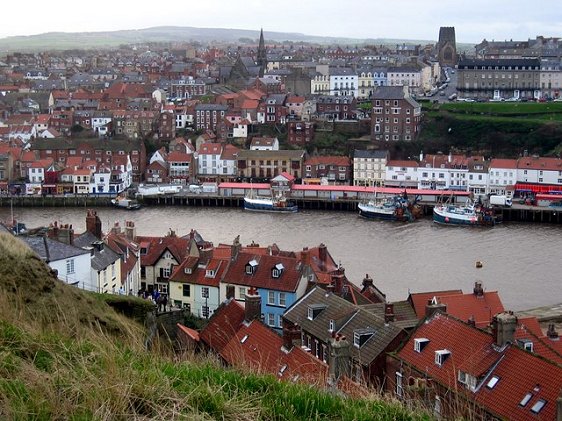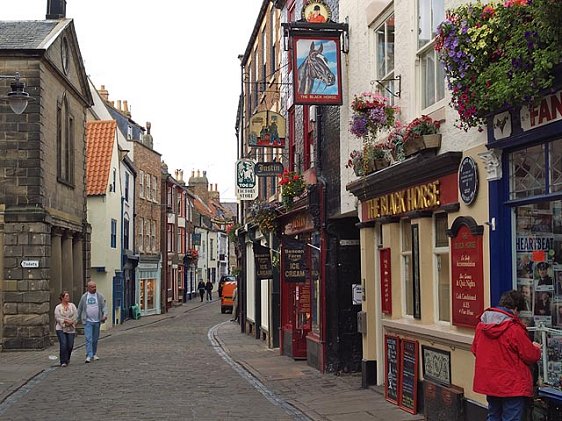 Whitby, North Yorkshire, England: Source: https://commons.wikimedia.org/wiki/File:East_Cliff.JPG
Whitby, North Yorkshire, England: Source: https://commons.wikimedia.org/wiki/File:East_Cliff.JPGAuthor: J3Mrs

Whitby is a seaside town in Scarborough district, on the coast of North Yorkshire, England. It has a population of around 15,000 people (2012 estimate).
The history of Whitby goes back to AD 656, when Oswy the Christian king of Northumbria, founded the first abbey there, under the abbess Hilda. This was the beginning of Whitby Abbey the following year. At that time, the settlement was called Streonshal. In 664 the Synod of Whitby was held there. In 867 Viking raiders plundered Streonshal and destroyed the abbey. When the abbey was re-founded in 1079, it was named Whitby Abbey. The name Whitby is Old Norse for "white settlement", and the village around the abbey also took on that name.
 River Eck, Whitby: Source: https://commons.wikimedia.org/wiki/File:River_Esk_at_Whitby_-_geograph.org.uk_-_1467412.jpg
River Eck, Whitby: Source: https://commons.wikimedia.org/wiki/File:River_Esk_at_Whitby_-_geograph.org.uk_-_1467412.jpgAuthor: Andrew Curtis

Whitby was a small fishing village which expanded in the 18th century, when it became a site for the shipbuilding and whaling industries. At one time, it was the third largest shipbuilding center in England behind London and Newcastle. In addition, it had an alum industry, founded in the 16th century by English naturalist Thomas Chaloner. These various enterprises made Whitby one of the wealthier towns in the area.
The location of three chalybeate springs in Whitby enabled Whitby to also develop into a spa town during the Georgian period. The construction of the Whitby and Pickering Railway in 1839 allowed the town to receive more visitors. This was the beginning of tourism as a form of recreation in Whitby.
Today tourism remains the mainstay of Whitby's economy, which is also supported by fishing. The geographic location of Whitby puts it in an isolated positon, leading to brain drain of the younger generation.
 Church Street, Whitby: Source: https://commons.wikimedia.org/wiki/File:Church_Street_-_geograph.org.uk_-_545568.jpg
Church Street, Whitby: Source: https://commons.wikimedia.org/wiki/File:Church_Street_-_geograph.org.uk_-_545568.jpgAuthor: Stephen McCulloch

Visiting Whitby
From London, take the A1(M) motorway to Junction 45, then continue east on the A64 road to York. Passing York, continue on the A64 until junction to the A169 road at Norton. Head north on the A169 road to reach Whitby.Places of Interest in Whitby
- Sneaton Castle: 19th century castle built by former sugar plantation baron James Wilson. He sold the plantation, with 200 slaves, when he moved to Whitby.
- Statue of Captain James Cook: Statue of the famous explorer who served his apprenticeship in Whitby.
- Whalebone Arch: Arch made from a pair of whalebones commemorates Whitby's historic position as a whaling center.
- Whitby Abbey: Ruined Benedictine abbey, today a Grade I listed heritage building managed by English Heritage. It dates from the first monastery founded here in 657 AD.
- Whitby Museum: Private museum run by the Whitby Literary and Philosophical Society. Opened in 1931, it showcases a range of items related to the history of the town.
- Whitby Piers: The East Pier and West Pier of Whitby are Grade II listed heritage sites. Each has a lighthouse and beacon.
- Whitby Swing Bridge: Bring spanning the Esk that divides the upper harbor from the lower harbor.
 Latest updates on Penang Travel Tips
Latest updates on Penang Travel Tips
About this website

Thanks for reading this page. My name is Timothy Tye. My hobby is to research information about places, and share the information with people on this website. I started this website on 5 January 2003, and since then, have written about over 20,000 places, mostly in Malaysia and Singapore.
Please use the information on this page as guidance only. While I try my best to provide you information that is as accurate as I can get it to be, I do apologize for any errors. Also, as I might not be able to update some information on time, some of these pages may contain outdated information.
Copyright © 2003-2024 Timothy Tye. All Rights Reserved.


 Go Back
Go Back